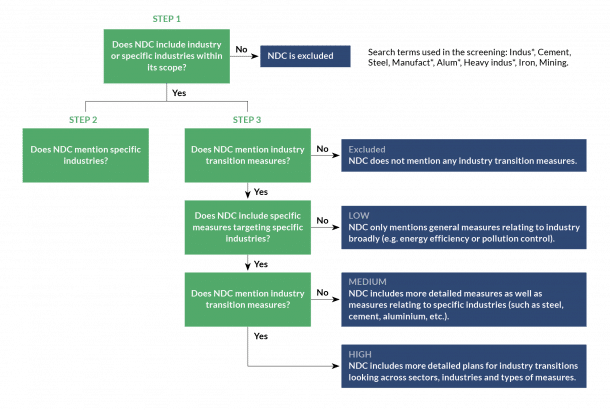Industry transitions: a critical gap in national climate commitments.

Photo: Caiaimage / Agnieszka Olek / Getty
Controlling greenhouse gas emissions from industry will be critical if the world is to meet the Paris Agreement target of keeping global heating “well below” 2°C by 2100. On current trajectories, global CO2 emissions from hard-to-abate industry sectors – such as aluminium, chemicals and petrochemicals, iron and steel, cement, shipping, aviation and heavy road transport – are expected to rise from 10.3Gt in 2014 to 15.7Gt (or c. 60% of global emissions) by 2050.
To avert this, a far-reaching transition of industry onto a low-carbon pathway is needed, across the world’s leading economies. But a study we carried out early this year suggests that most of the the mitigation proposals countries have submitted under the Paris Agreement are woefully short on detail when it comes to industrial transition plans.
The study
Earlier this year, we set out to search the current batch of nationally determined contributions (NDCs) countries have proposed under the Paris Agreement to see what mitigation measures were planned to support low-carbon industrial transitions.
We screened all 134 of the NDCs submitted in English currently available (including the European Union’s regional NDC), in three steps:
- Step 1: Does the NDC include industry within the scope of its mitigation targets?
- Step 2: Does the NDC mention specific industries?
- Step 3: Does the NDC include any industry transition measures? If so, how far does it go?
To answer the last question we devised a rating system, which we dubbed the “NDC Industry Scorecard”, based on the degree of specificity and broad sectoral coverage of the proposed measures. (We did not attempt to evaluate their likely impact on emissions.) The figure below shows these steps in more detail.

The study
We found that around 69% of the NDCs included industry, or specific industries, within the scope of their mitigation targets. Most of the NDCs that didn’t include industry were from countries with very low emissions from industry, such as small-island developing states (SIDS).
However, nearly two-thirds of those 92 NDCs only mentioned industry in a general sense and did not specify which industries were targeted. When NDCs did mention a specific industry it was most often cement production, followed by building and manufacturing more broadly.

When it comes to concrete action, 43 NDCs (32% of the total we looked at) included specific mitigation measures for industry – less than half the number that included industry within their scope.
Using the scorecard, we gave 21 NDCs a “low” score and 16 NDCs a “medium” score. Only 6 of the 43 NDCs specifying any transition measures for industry were detailed and comprehensive enough to constitute something akin to an industrial transition roadmap (and thus achieve a “high” score).
On a more positive note, these high scoring NDCs included the world’s top greenhouse gas emitter, China, and its third-biggest and fifth-biggest emitters, India and Japan. The others were Indonesia, Morocco and Uruguay. We’ve listed the measures proposed by each of these countries.
Bridging the gap
From our findings we can say that a sizeable majority of countries – nearly 70% – that have submitted an NDC in English acknowledge the importance of industry in climate mitigation. However, in most cases the NDCs themselves offer scant evidence of concrete transition plans.
There is an urgent need for countries to draw up transparent industry transition roadmaps that can support the implementation of the Paris Agreement. This presents a clear opportunity for the Leadership Group for Industry Transitions – which meets in Madrid on Monday 9 December – to realize a key part of its mission.
Launched by the Swedish and Indian governments at the UN Climate Action Summit in New York in September 2019, the Leadership Group comprises countries, companies and other actors who believe that all sectors of industry can and must progress on low-carbon pathways, while pursuing efforts to reach net-zero carbon emissions by mid-century.
Initiatives like the Leadership Group are vital to demonstrate the feasibility of net-zero pathways and to spur others to accelerated action and increasing ambition. We hope that more countries will step up to the challenge and set out clear, viable industrial transition plans in the next round of NDCs.
